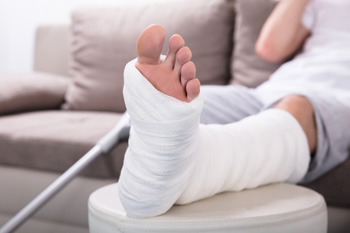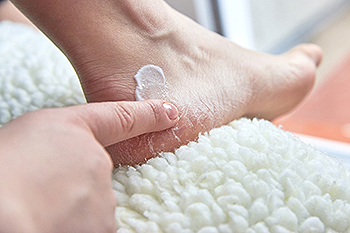 Broken ankles are usually caused by the ankle turning, twisting, or rolling while walking, running, or participating in sports. An ankle can also break from repetitive stress (stress fracture) or high-impact trauma to the ankle, like a fall or an auto accident (traumatic ankle fracture). Some ankle fractures can occur where bones break but remain in correct alignment, while in other instances, portions of the bone become separated or misaligned. Pain and swelling will typically occur in the ankle area and parts of the foot, and might radiate up to the knee. Putting weight on the affected ankle can make all symptoms worse. Different types of fractures require different treatment based on alignment and stability of the ankle. X-rays, a CT scan or an MRI may be needed to determine the extent of the injury. Seeing a podiatrist will help determine which type of fracture has been sustained and the proper course of treatment to help preserve the ankle joint for life.
Broken ankles are usually caused by the ankle turning, twisting, or rolling while walking, running, or participating in sports. An ankle can also break from repetitive stress (stress fracture) or high-impact trauma to the ankle, like a fall or an auto accident (traumatic ankle fracture). Some ankle fractures can occur where bones break but remain in correct alignment, while in other instances, portions of the bone become separated or misaligned. Pain and swelling will typically occur in the ankle area and parts of the foot, and might radiate up to the knee. Putting weight on the affected ankle can make all symptoms worse. Different types of fractures require different treatment based on alignment and stability of the ankle. X-rays, a CT scan or an MRI may be needed to determine the extent of the injury. Seeing a podiatrist will help determine which type of fracture has been sustained and the proper course of treatment to help preserve the ankle joint for life.
Broken ankles need immediate treatment. If you are seeking treatment, contact Edwin Oghoorian, DPM from Pacific Foot & Ankle Associates . Our doctor can provide the care you need to keep you pain-free and on your feet.
Broken Ankles
A broken ankle is experienced when a person fractures their tibia or fibula in the lower leg and ankle area. Both of these bones are attached at the bottom of the leg and combine to form what we know to be our ankle.
When a physician is referring to a break of the ankle, he or she is usually referring to a break in the area where the tibia and fibula are joined to create our ankle joint. Ankles are more prone to fractures because the ankle is an area that suffers a lot of pressure and stress. There are some obvious signs when a person experiences a fractured ankle, and the following symptoms may be present.
Symptoms of a Fractured Ankle
- Excessive pain when the area is touched or when any pressure is placed on the ankle
- Swelling around the area
- Bruising of the area
- Area appears to be deformed
If you suspect an ankle fracture, it is recommended to seek treatment as soon as possible. The sooner you have your podiatrist diagnose the fracture, the quicker you’ll be on the way towards recovery.
If you have any questions, please feel free to contact our office located in San Dimas, CA . We offer the newest diagnostic and treatment technologies for all your foot care needs.
Read more about All About Broken AnkleThe arch is the curved area in the center sole of the foot. At birth, babies do not have arches in their feet, but most will develop arches over time. Those who don’t develop arches have congenital flat feet, which are usually asymptomatic. It is also possible to develop arches normally and then lose them over time for a variety of reasons. This is known as acquired flat feet, and is often accompanied by foot pain or discomfort. But why do we have arches in the first place? The arch of the foot is a very useful structure. It helps the feet stand, stay balanced, run, walk, and jump by adding flexibility and springiness to the foot. With an arch, the foot is better able to absorb shock from physical activities, and the body’s weight is more evenly distributed around the surface of the foot. If you have flat feet and are experiencing any foot pain, please seek the care of a podiatrist.
Flatfoot is a condition many people suffer from. If you have flat feet, contact Edwin Oghoorian, DPM from Pacific Foot & Ankle Associates . Our doctor will treat your foot and ankle needs.
What Are Flat Feet?
Flatfoot is a condition in which the arch of the foot is depressed and the sole of the foot is almost completely in contact with the ground. About 20-30% of the population generally has flat feet because their arches never formed during growth.
Conditions & Problems:
Having flat feet makes it difficult to run or walk because of the stress placed on the ankles.
Alignment – The general alignment of your legs can be disrupted, because the ankles move inward which can cause major discomfort.
Knees – If you have complications with your knees, flat feet can be a contributor to arthritis in that area.
Symptoms
- Pain around the heel or arch area
- Trouble standing on the tip toe
- Swelling around the inside of the ankle
- Flat look to one or both feet
- Having your shoes feel uneven when worn
Treatment
If you are experiencing pain and stress on the foot you may weaken the posterior tibial tendon, which runs around the inside of the ankle.
If you have any questions please feel free to contact our office located in San Dimas, CA . We offer the newest diagnostic and treatment technologies for all your foot and ankle needs.
Read more about What is Flexible Flat Foot?Cracked heels, or heel fissures, can develop when skin on the heel dries out and becomes callused. This dried out skin can then crack when weight placed on the heel causes the fat pad under the heel to spread out. If these cracks are left untreated, they can deepen to the point where they bleed or even become infected. This is not only painful, but can be very dangerous—especially for individuals with diabetes. Certain factors—along with having dry, thickened skin—can contribute to the formation of cracked heels, such as standing for prolonged periods of time, going barefoot, wearing open-backed shoes, and carrying extra weight. Also, diabetes, hypothyroidism, atopic dermatitis, psoriasis, and other conditions that can cause dry skin can be associated with cracked heels. Sometimes, cracked heels can be lessened by using topical water-retaining creams. If your cracked heels do not improve with regular moisturizing, if they are deep or bloody, or if you have diabetes, it is suggested that you seek professional treatment from a podiatrist.
Cracked heels are unsightly and can cause further damage to your shoes and feet. If you have any concerns, contact Edwin Oghoorian, DPM from Pacific Foot & Ankle Associates . Our doctor can provide the care you need to keep you pain-free and on your feet.
Cracked Heels
Cracked heels appear unappealing and can make it harder for you walk around in sandals. Aside from looking unpleasant, cracked heels can also tear stockings, socks, and wear out your shoes. There are several methods to help restore a cracked heel and prevent further damage.
How Do You Get Them?
Dry skin is the number one culprit in creating cracked heels. Many athletes, walkers, joggers, and even swimmers suffer from cracked heels. Age and skin oil production play a role to getting cracked heels as well.
Promote Healing
Over the counter medicines can help, especially for those that need instant relief or who suffer from chronic dry feet.
Wear Socks – Wearing socks with medicated creams helps lock in moisture.
Moisturizers – Applying both day and night will help alleviate dryness which causes cracking.
Pumice Stones – These exfoliate and remove dead skin, which allows for smoother moisturizer application and better absorption into the skin.
Change in Diet
Eating healthy with a well-balanced diet will give the skin a fresh and radiant look. Your body responds to the kinds of food you ingest. Omega-3 fatty acids and zinc supplements can also revitalize skin tissue.
Most importantly, seek professional help if unsure how to proceed in treating cracked heels. A podiatrist will help you with any questions or information needed.
If you have any questions, please feel free to contact our office located in San Dimas, CA . We offer the newest diagnostic and treatment technologies for all your foot care needs.
Read more about Solutions for Cracked Heels


